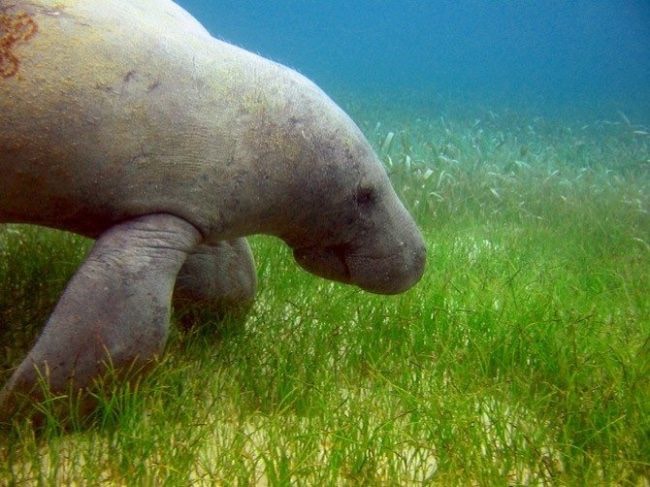Among the wide range of marine mammals that inhabit our waters, is the critically endangered dugong, also known as the sea cow or lady of the sea.
The What?
The dugong (Dugong dugon) is one of the smaller marine mammals that roam the seas. Dugongs are dun or grey in colour, are generally around 2.4 ‒ 2.7 metres in length, and have large, rotund bodies. Their skin appears to be smooth, although it’s actually rough, and covered in pits from which thick, short hairs sprout. The dugong’s snout is sharply downturned and covered in bristles ‒ an adaptation for grazing and uprooting seagrasses. The tail is broad and spade-like.
They are slow-moving creatures, generally swimming at around 9 kmph, although they can double this speed when threatened. A dugong can stay submerged for 6 ‒ 10 minutes, and their young can sometimes be seen riding on their mothers’ backs. Their slow metabolic rates makes it difficult for them to tolerate low water temperatures as well as sudden changes in the weather. A dugong’s favourite food is sea grass, which they graze upon by day as well as by night.
In Sri Lankan waters, they are normally found in groups of up to three, and prefer the warm shallow coastal waters and estuaries ‒ these places have a healthy ecosystem that can support large beds of seagrass and other vegetation. The Palk bay, the Arippu pearl banks, Adam’s bridge and the islands west of Jaffna, as well as the Gulf of Mannar, are areas which they prefer. Still, dugong sightings are quite rare.
According to the IUCN Conservation Status, the dugong is considered to be critically endangered. The hunting of dugongs continued until the 1970s, at which point they were afforded protection under amendments made to the Fauna and Flora Protection Act.
Though no longer “hunted” per se, they are constantly getting entangled in fishing nets, or die as a result of dynamiting by fishermen, or by being hit by tourist boats. Slaughter, though reduced, still continues.
A few years ago, two large specimens of dugongs ‒ possibly the largest ever recorded in the world ‒ were killed by poachers. The remains of the male dugong, at 480 kg, and the female at 525 kg, were taxidermied and are now in the NARA museum.
Conservation Status

A global effort to protect dugongs and their seagrass habitats has been initiated in eight countries, including Sri Lanka.
The Dugong and Seagrass Conservation project, a global effort to conserve dugongs and their seagrass habitats, was initiated in eight countries in the Indo-Pacific region. These are Indonesia, Madagascar, Malaysia, Mozambique, Solomon islands, Sri Lanka, Timor-Leste and Vanuatu.
This is the first coordinated global effort to conserve dugongs and their seagrass habitats, and has been dubbed a “community-based effort with global reach”.
In Sri Lanka, the project takes on several strategies, which, broadly speaking, aim at:
The project is being carried out through several partner organisations, including the UNDP GEF Small Grants Project, Biodiversity Education and Research (BEAR), and the Department of Wildlife Conservation.
Why Focus Specifically On Seagrass s Well?

Seagrass is the dugong’s favourite food, so conserving seagrass is an important step in protecting dugongs. Image courtesy: greenlifesociety.org
Seagrasses are flowering plants that grow in meadows on the seabeds of shallow coastal areas. They occupy a mere 0.2% of the world’s oceans but are far more effective at storing CO2 than typical terrestrial rainforests. They filter pollutants and maintain water quality, provide food, protection, and shelter to a multitude of ocean creatures and also protect the coast from erosion.
And, these are the dugong’s favourite food. Therefore, in order to save the dugong, it is important to conserve the food sources that they depend on as well.
However, seagrasses have been disappearing at an alarming rate of 110 km² a year since 1980. The urgency in protecting these meadows is thus quite evident.
Information sourced from The Dugong and Seagrass Conservation Project and Out of the Blue, a guide to the marine mammals of Sri Lanka, Southern India and the Maldives – By Howard Martenstyn
Featured image courtesy: wikipedia.org











![TV-Poster-All-Exhibition-Sri-Lanka-in-Focus-USA-2025[1]](https://www.srilankafoundation.org/wp-content/uploads/2025/04/TV-Poster-All-Exhibition-Sri-Lanka-in-Focus-USA-20251-450x450.jpg)










